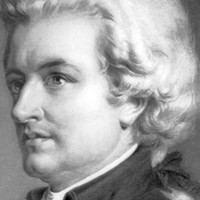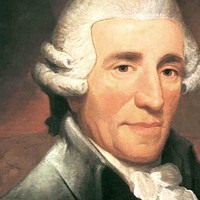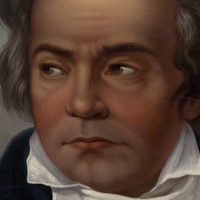Opening Weekend: Beethoven’s Seventh Symphony


 Listen to Audio
Listen to Audio
The Marriage of Figaro was the first of Mozart’s three collaborations with the Italian librettist Lorenzo da Ponte, who also scripted Don Giovanni and Così fan tutte. It was possibly Mozart’s idea to borrow the scenario from a 1778 French play by Pierre Beaumarchais, a sequel to his earlier hit, The Barber of Seville (later immortalized in Rossini’s 1816 opera). The farce was banned in Vienna at the time for its sarcastic condemnation of the aristocracy, and da Ponte had to scrub the work of its political overtones to gain the emperor’s approval.
The Marriage of Figaro transpires over the course of “one crazy day.” Figaro, the head servant to Count Almaviva, is due to wed the maid Susanna, who meanwhile has been subjected to the Count’s lecherous advances. In the end, the Count gets his comeuppance, and Figaro and Susanna marry. Although the music of the overture has no major presence later in the opera, it sets the scene for the hilarity that ensues. The overture’s form is quite lean, with neither a repeat of the exposition nor a development section. The frenetic Presto tempo and persistent eighth-notes give the prelude a breathless feeling throughout its four-minute sprint, while rising figures and drawn-out crescendos establish the buoyant tone of the opera.
Aaron Grad ©2013

Franz Joseph Haydn had been serving the Esterhazy family for 30 tireless years when a new prince decided to disband the court’s orchestra and cut back the role of their longtime Kapellmeister. Not that Haydn had any need to worry; after an earlier contract negotiation gave him freedom to publish scores, his music had spread all over Europe and made him the most famous composer alive. Johann Peter Salomon, a German impresario active in England, seized the opportunity and invited Haydn to spend the 1791-92 season in London.
While Salomon and Haydn presented weekly concerts on Mondays in the Hanover Music Rooms, a competing group occupied the same venue on Thursdays for performances featuring Ignaz Pleyel, one of Haydn’s former composition students. As Haydn put it in a letter to a friend in Vienna, “Now a bloody harmonious war will commence between master and pupil.”
Adopting a recent French trend, the Sinfonia concertante, Pleyel impressed his London audiences with diverse concertos for multiple soloists. Not to be outdone, Haydn designed a Sinfonia concertante of his own, using a solo quartet of violin, cello, oboe, and bassoon. By choosing four soloists that encompass a full sweep through the bass and treble registers, Haydn put himself on terrain that was familiar from his dozens of string quartets, and often the soloists play as if they are a self-contained chamber music group, with their statements framed by the subtlest of plucks from the strings or long tones from the winds.
The central Andante emphasizes the singing qualities of the soloists, placing them in shifting duets and trios in sweet harmony. The finale continues in an operatic vein, interrupting the action for free-flowing recitatives from the solo violin.
Aaron Grad ©2022

Thomas Adès only dedicated himself to composing at age nineteen, a year after earning second place in the BBC’s Young Musician of the Year competition as a pianist. In his twenties, he rose to the top echelon of contemporary music, causing a stir with the risqué opera Powder her Face (1995) and becoming the youngest ever winner of the prestigious Grawemeyer Prize for his orchestral work Asyla (1997).
Another early Adès work that has held its lasting place in the repertoire is his first string quartet from 1994, Arcadiana. As the Merriam-Webster dictionary tells us, “English speakers often use arcadia to designate a place of rustic innocence and simple, quiet pleasure.” Adès’ Arcadiana is a study of such places — some tangible, and others as rendered by composers and other artists. In a preface to the score, Adès simply referred to “more local fields” as his inspiration for the tranquil sixth movement, which takes its name from a very old name for England, Albion.
Aaron Grad ©2021
 Watch Video
Watch Video
Western classical music is frequently tied to politics, as was the case with Ludwig van Beethoven and several of his symphonies. Most noteworthy, perhaps, was Beethoven’s dedication of his third symphony to Napoleon, which the composer erased upon learning that Napoleon had declared himself emperor. Beethoven’s Symphony No. 7 is also often interpreted as a musical confrontation with Napoleon, whose troops had recently occupied Vienna.
Beethoven composed Symphony No. 7 between 1811 and 1812, at the same time Napoleon was planning his campaign against Russia. The piece was dedicated to Count Moritz von Fries, an Austrian patron of the arts, and the Russian Empress Elisabeth Aleksiev. In December 1813, Beethoven conducted the premiere at the University of Vienna. The event was a charity concert for soldiers wounded in the Battle of Hanau, and Beethoven remarked at the concert’s opening that “we are moved by nothing but pure patriotism.”
The first movement of Symphony No. 7 begins with a long, slow introduction composed of ascending scales. This introduction transitions to the Vivace section through a series of sixty-one repetitions of the pitch E. Dance-like rhythms permeate the entire symphony, including the first theme of the Vivace section. The last few minutes of the movement feature a coda, which contains a remarkable passage of a two-measure motive that is repeated ten times in a row. This repeated motive occurs at the same time as the other instruments play a four-octave pedal point on the pitch E.
So popular that it was encored at the premiere, the second movement of Symphony No. 7 is often performed today as a stand-alone piece. The movement is in ternary form, or three large sections. The first and third sections are composed of similar thematic material and feature a repeated ostinato pattern of a quarter note, two eighth notes, and two quarter notes. These two sections are in the key of A minor, and Beethoven demonstrates his skill with imitative counterpoint in the third section, which is structured as a fugato. The contrasting middle section in A major contains a warm melody in the clarinets, which is accompanied by triplets in the violins.
A scherzo is a musical joke in which humor is created through compositional devices such as unequal phrase structures, disjunct rhythms, alternating meters and unexpected harmonies. Beethoven employs most of these techniques in the third movement of Symphony No. 7, which is divided into five large sections alternating ABABA. The A sections are rhythmically vigorous and composed of jagged, irregular phrases. The B sections contain quotations of the Austrian pilgrims’ hymn.
Symphony No. 7 closes with a movement full of fiery, relentless passion and perpetual motion. The first theme of the movement is a modified version of the instrumental ritornello to Beethoven’s own arrangement of the Irish folk song “Save me from the grave and wise.” Symphony No. 7 was regarded by Beethoven as one of his best compositions, and a newspaper account of an early performance recalled that the “applause rose to the point of ecstasy.”
Paula Maust ©2022
Get driving directions and find nearby parking.
Find dining options close to the venue.
View seating charts to find out where you'll be seating.
SPCO concerts are made possible by audience contributions.
For exclusive discounts, behind-the-scenes info, and more:
Sign up for our email club!
